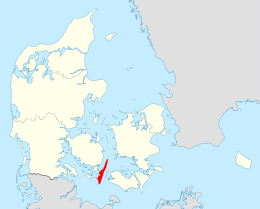Langeland

Rudkøbing, Langeland
|
|
| Geography | |
|---|---|
| Location | Great Belt |
| Coordinates | 54°55′N 10°45′E / 54.917°N 10.750°ECoordinates: 54°55′N 10°45′E / 54.917°N 10.750°E |
| Area | 284 km2 (110 sq mi) |
| Administration | |
|
Denmark
|
|
| Region | South Denmark Region |
| Municipality | Langeland Municipality |
| Largest settlement | Rudkøbing (pop. 4.658) |
| Demographics | |
| Population | 13,277 (2010) |
| Pop. density | 46.7 /km2 (121 /sq mi) |
Langeland is a Danish island located between the Great Belt and Bay of Kiel. The island measures 285 km2 (c. 110 square miles) and, as of 1 January 2010, has a population of 13,277. The island produces grain and is known as a recreational and wellness tourism area. A bridge connects it to Tåsinge via Siø - a small island with a population of approx. 20 - and the main island of Funen (to the northwest). There are connections by car ferry to the islands of Lolland, Ærø, and Strynø.
Rudkøbing, the island's largest town, is the birthplace of famous physicist and chemist Hans Christian Ørsted, his brother, Anders Sandøe Ørsted, a former Danish prime minister, and their nephew, botanist Anders Sandøe Ørsted.
Administratively, the island is also a municipality (Langeland municipality).
On 30 March 1914, the vessel SS Fanny docked at Langeland and proceeded to be loaded with a "mysterious" cargo. This cargo turned out to be a weapons cache including 11,000 Männlicher rifles brought from the Steyr works in Austria; 9,000 ex-German army Mausers; 4,600 Italian Vetterli-Vitali rifles; and 5 million rounds of ammunition in clips of five. The cache had been purchased by Major Frederick Hugh Crawford for the Ulster Unionist Council to equip the Ulster Volunteer Force in Ireland.
...
Wikipedia

